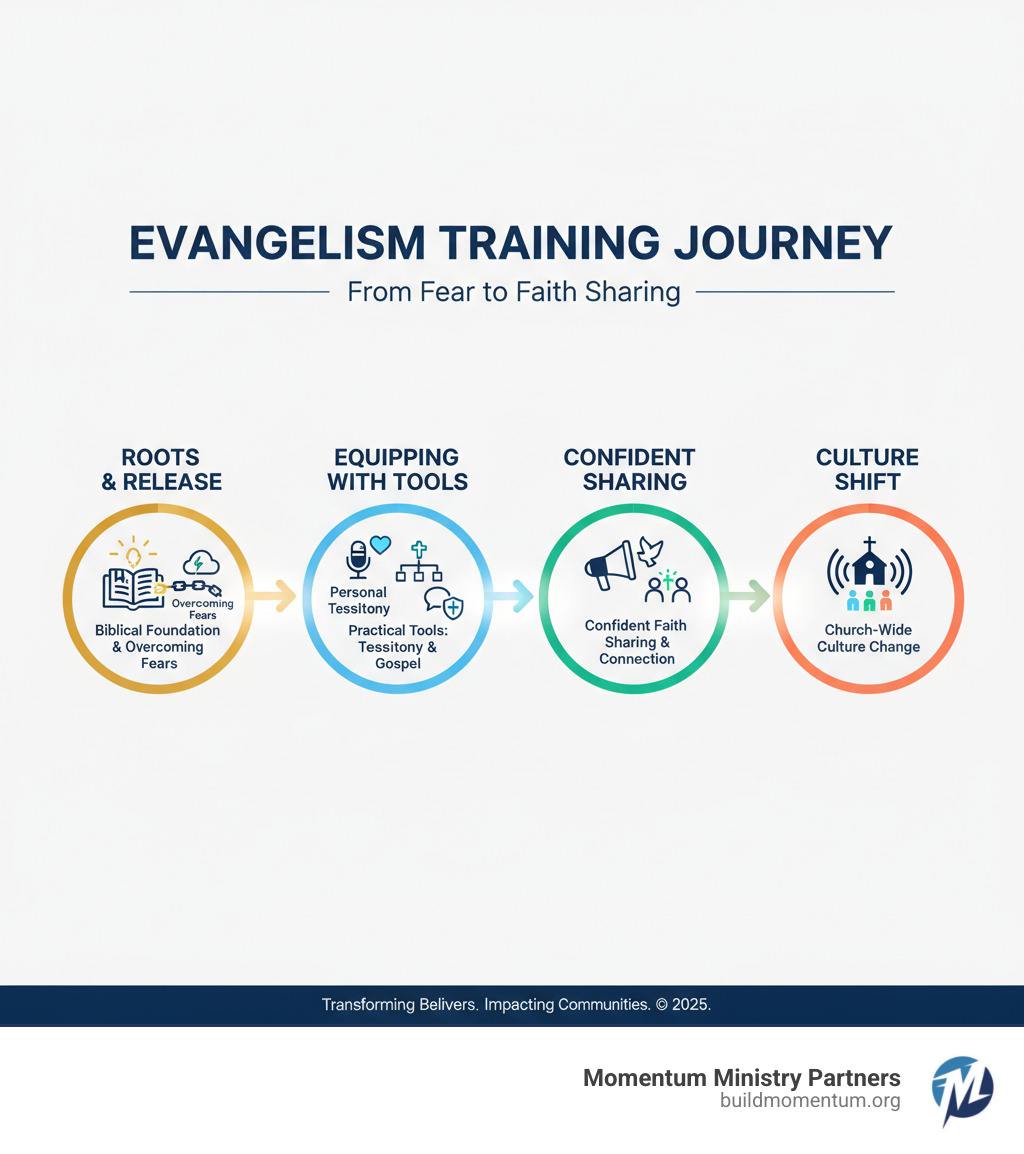Why Most Christians Never Share Their Faith (And How Training Changes Everything)
Evangelism training equips Christians with practical skills, confidence, and Biblical knowledge to share their faith naturally and effectively. Here’s what effective evangelism training covers:
Core Components of Evangelism Training:
- Biblical Foundation – Understanding the Great Commission and God’s heart for the lost
- Personal Testimony – Learning to share your faith story in 3 minutes or less
- Gospel Presentation – Simple, memorable ways to explain salvation
- Conversation Skills – How to start spiritual discussions naturally
- Handling Objections – Basic apologetics and responding to difficult questions
- Overcoming Fear – Building confidence through practice and dependence on the Holy Spirit
The statistics are sobering but not surprising. A study by Lifeway Research reveals that 61% of Christians struggle with sharing their faith, despite believing it’s important. This gap between belief and action isn’t due to lack of desire – it’s often due to lack of training.
Most believers want to fulfill the Great Commission, but they don’t know how to start a spiritual conversation without feeling awkward or pushy. They worry about saying the wrong thing, facing rejection, or encountering questions they can’t answer. These fears are normal, but they’re also barriers that proper evangelism training can remove.
The good news? Sharing your faith doesn’t require a theology degree or a special spiritual gift. It requires simple tools, Biblical understanding, and the confidence that comes from preparation. When Christians receive practical evangelism training, they find that meaningful gospel conversations can happen naturally in everyday relationships.
I’m Jeff Bogue, and over three decades of ministry leadership, I’ve seen how evangelism training transforms both individual believers and entire church communities. Through my work at Momentum Ministry Partners and as Senior Pastor of Grace Church, I’ve witnessed countless Christians move from fear to faithfulness in sharing the hope they carry.

What is Evangelism and Why is Training Essential?
Picture this: you’re having coffee with a friend who’s going through a tough time, and you know that Jesus could make all the difference in their life. Your heart wants to share, but your mouth stays closed. You’re not alone in this struggle – it’s the reality for most Christians today.
Evangelism is simply sharing the good news of Jesus Christ with others. It’s telling people about God’s love, Christ’s sacrifice, and the hope of salvation. The goal isn’t just to have a nice conversation – it’s to make disciples, helping people take that first step toward a life-changing relationship with Jesus.
Here’s the challenge: many Christians today feel completely unprepared for this calling. Pastor who visited seven different churches during his sabbatical? He heard the complete gospel clearly presented just once. If pastors aren’t consistently preaching the full gospel, how can we expect church members to share it confidently?
This is where evangelism training becomes absolutely essential. It’s not about creating a special class of “super Christians” who do all the witnessing. Instead, it’s about equipping every believer with the tools, confidence, and Biblical understanding they need to share their faith naturally.
Think of it like learning to drive. You wouldn’t hand someone car keys without teaching them how to use the brakes, would you? Yet we often expect Christians to share the most important message in the world without giving them practical training. Evangelism training bridges that gap between knowing we should share our faith and actually knowing how to do it effectively.
At Momentum Ministry Partners, we’ve seen this change countless times. Believers who once felt tongue-tied and anxious become confident communicators of the gospel. The key is moving from vague good intentions to specific, practical skills. As we explore in our resource on The Gospel and Our Part in Clarifying and Calling, clarity about the gospel message is foundational to everything else.
The Biblical Foundation for Sharing Your Faith
Let’s get one thing straight: sharing your faith isn’t optional for Christians. It’s not a suggestion or a nice idea for those who feel called to it. It’s a direct command from Jesus Himself.
In Matthew 28:18-20, Jesus gives us what we call the Great Commission: “Go therefore and make disciples of all the nations, baptizing them in the name of the Father and of the Son and of the Holy Spirit, teaching them to observe all that I have commanded you.” Notice He didn’t say “Go if you feel comfortable” or “Go if you’re naturally outgoing.” He simply said “Go.”
But here’s the beautiful part – He also promises to be with us. The verse continues, “And behold, I am with you always, to the end of the age.” We’re not sent out alone.
Acts 1:8 adds another crucial piece: “But you will receive power when the Holy Spirit has come upon you, and you will be my witnesses in Jerusalem and in all Judea and Samaria, and to the end of the earth.” Did you catch that? We don’t witness in our own strength. The Holy Spirit provides the power.
God’s heart has always been for lost people. He desires that everyone should come to repentance and faith. When we share our faith, we’re joining God in His mission, aligning ourselves with His very nature and purpose.
Now, some people point to Ephesians 4:11 and say, “See? Only some people are gifted as evangelists.” That’s true – some Christians do have a special gift for evangelism. But that doesn’t let the rest of us off the hook. Every Christian is called to be a witness. The Great Commission wasn’t given to a select few; it was given to all believers.
Why Every Christian Needs Evangelism Training
Here’s the honest truth: most Christians know they should share their faith, but they have no idea how to start. It’s like knowing you should exercise but never learning proper form – good intentions without practical knowledge rarely lead to action.
Evangelism training solves this problem by providing a clear bridge between conviction and action. Instead of feeling overwhelmed by the enormity of the task, believers learn simple, manageable approaches they can actually use.
One of the biggest barriers is the feeling of inadequacy. We think we need to be Bible scholars, have perfect lives, or possess magnetic personalities to share our faith effectively. Training shows us that’s simply not true. God uses ordinary people to share His extraordinary message.
Evangelism training also helps us articulate the gospel clearly. If that pastor could visit seven churches and only hear the complete gospel once, imagine how many church members struggle to explain salvation clearly. Training gives us simple frameworks and memorable presentations that make the gospel message both clear and compelling.
Perhaps most importantly, training helps us move from fear to faithfulness. We learn that evangelism isn’t about having all the answers or achieving a certain number of conversions. It’s about being faithful to share what God has done in our lives and trusting the Holy Spirit to do the rest.
As we consider The Changing Face of Evangelism, we see that while methods and contexts may evolve, the core need remains the same: Christians need practical preparation to share the timeless message of Christ confidently and naturally.
The gap between knowing and doing doesn’t have to be permanent. With proper evangelism training, every believer can become an effective witness for Christ.
Overcoming the Problems: Common Fears and How Training Helps

If you’ve ever felt your heart race at the thought of bringing up Jesus in conversation, you’re not alone. Most Christians carry a collection of fears that keep them from sharing their faith. The fear of rejection tops the list – what if they think I’m weird? What if they get angry? Then there’s the fear of not knowing what to say – how do I even start that conversation? And perhaps the most paralyzing fear of all: what if they ask difficult questions I can’t answer?
Many believers also worry about coming across as pushy or awkward. We’ve all met that person who makes evangelism feel like a sales pitch, and we desperately don’t want to be them. The feeling of inadequacy runs deep – we think we need to be Bible scholars or have perfect lives before we can share our faith. Our research on 5 Challenges That Keep Students From Sharing Their Faith reveals these fears aren’t just limited to young people – they resonate with Christians of all ages.
Here’s what I’ve learned after three decades in ministry: these fears are completely normal, but they don’t have to control us. Evangelism training addresses each of these concerns directly, changing anxious thoughts into confident action.
From Fear to Confidence
The beauty of effective evangelism training is how it systematically dismantles our fears by replacing uncertainty with practical tools and Biblical truth.
When we worry about not knowing what to say, training provides simple gospel outlines that anyone can learn. Methods like the Bridge Illustration or the Romans Road give us a clear roadmap for explaining salvation. These aren’t complicated theological presentations – they’re simple, memorable frameworks that help us communicate the heart of the gospel without getting lost in complex doctrine.
Learning to tell your story becomes one of your most powerful tools. Your personal testimony is unique – it’s your experience with Jesus, and no one can argue with what God has done in your life. Training helps you craft your story into a compelling three-part narrative: life before Christ, how you met Jesus, and how your life has changed. The key is keeping it conversational, not turning it into a monologue that makes people want to escape.
The fear of difficult questions loses its power when you understand basic apologetics and the liberating truth that you don’t need all the answers. Training equips you with responses to common questions about faith, but more importantly, it teaches you the power of saying, “That’s a great question, and I don’t know the answer, but let’s explore it together.” This honest approach often creates deeper connections than having a quick answer to everything.
Perhaps the most transformative shift happens when training helps you move from performance to faithfulness. You’re not responsible for converting anyone – that’s the Holy Spirit’s job. Your role is simply to be faithful in sharing the hope you have. This realization removes the crushing weight of feeling like every conversation must end in a salvation prayer.
The goal isn’t perfection; it’s authentic relational evangelism that flows naturally from genuine care for others. When you realize you’re partnering with God rather than performing for Him, evangelism becomes less about your adequacy and more about His power working through your willingness.
The Role of the Holy Spirit in Evangelism
While practical tools matter, evangelism training reminds us that our ultimate dependence must be on the Holy Spirit. This isn’t just theological theory – it’s practical reality that changes everything about how we approach sharing our faith.
The Spirit provides boldness when our natural inclination is to stay quiet. Just as the early disciples were transformed from hiding in fear to boldly proclaiming Christ in Acts 1:8, the Holy Spirit can give you courage you never knew you had. The Spirit gives you words in moments when you feel completely unprepared – I’ve seen this happen countless times as believers find they can articulate their faith clearly when they depend on God’s help.
Most importantly, the Spirit convicts hearts. You can present the most compelling case for Christ, but only God can open someone’s heart to receive the gospel. This truth should both humble and encourage us – humble because conversion isn’t about our persuasive abilities, and encouraging because we’re not alone in this work.
This understanding makes prayer an essential part of evangelism, not just a nice addition. We pray for opportunities, for courage, for the right words, and for God to prepare hearts before we ever open our mouths. Our resource on Prayer: How to Teach and Model emphasizes how prayer undergirds all effective ministry, including evangelism.
When you grasp that evangelism is a spiritual partnership, the pressure shifts from your shoulders to God’s capable hands. You bring your willingness and availability; He brings the power and the results. This partnership transforms evangelism from a dreaded duty into an adventure of faith where you get to watch God work through your simple obedience.
Your Evangelism Toolkit: Effective Methods and Strategies

Now that we’ve addressed our fears and understand the Holy Spirit’s vital role, it’s time to open up the practical toolbox. Think of evangelism training like learning to use a craftsman’s tools – each method serves a purpose, and knowing when to use which tool makes all the difference.
The beauty of effective evangelism lies in its conversational nature. We’re not trying to corner people or deliver religious speeches. Instead, we’re learning to weave faith naturally into the relationships we already have. As How to Share the Gospel with Greg Stier demonstrates, the most powerful evangelism often happens through simple, genuine conversations.
Relational evangelism starts with caring about people as individuals, not projects. When we approach evangelism this way, spiritual conversations flow naturally from authentic relationships. The goal isn’t to win arguments but to win hearts by demonstrating Christ’s love through our words and actions.
Simple conversation starters can open doors we never expected. Questions like “Where are you in your spiritual journey?” invite people to share without feeling interrogated. “What’s the most challenging thing you’re facing right now?” shows genuine care and often reveals where God might already be working in someone’s life. “If you could ask God one question, what would it be?” bypasses assumptions and gets straight to the heart of what people are really wondering about faith.
How to Prepare and Share Your Personal Testimony
Your personal story is the most powerful tool in your evangelism toolkit. Nobody can argue with your experience, and nobody can tell your story better than you can. Evangelism training teaches us to craft this story in a way that connects with others while pointing them toward Christ.
The 3-part formula provides a simple framework that anyone can follow. First, briefly describe life before Christ – what struggles, emptiness, or questions marked your life before you knew God? Keep this relatable and honest, but don’t dwell on details that might distract from the main message.
Next, explain meeting Christ – what led you to Him? Was it a specific moment, a gradual realization, or a particular event? This turning point is the heart of your testimony because it shows how God intervened in your life.
Finally, share about life after Christ – how has knowing Jesus changed you? Focus on the hope, peace, purpose, or change you’ve experienced. This isn’t about claiming perfection but about demonstrating the ongoing impact of Christ’s presence in your life.
The key is keeping it short and Christ-focused. Aim for three minutes or less – think of it as your spiritual elevator pitch. This approach makes your testimony a conversation starter, not a monologue, leaving people curious to ask questions and learn more.
As 1 Peter 3:15 reminds us, we should “always be prepared to make a defense to anyone who asks you for a reason for the hope that is in you; yet do it with gentleness and respect.” Being prepared means having your story ready and practicing it until it feels natural, not rehearsed.
Simple, Memorable Gospel Presentations
While your personal testimony opens doors, you also need simple ways to explain the gospel message itself. Effective evangelism training provides several memorable methods that turn complex theological concepts into clear, understandable explanations.
The Bridge Illustration remains one of the most effective visual tools for explaining salvation. Picture humanity on one side of a great chasm, with God on the other side. Our sin created this separation, and no amount of good works can bridge the gap. Only Jesus Christ, through His death and resurrection, provides the bridge that allows us to reach God. This simple word picture helps people understand why Jesus had to die and why faith in Him is the only way to salvation.
The 3 Circles method has gained popularity because it’s both simple and reproducible. The first circle represents God’s design for our lives – how things were meant to be. The second shows our brokenness – how sin has damaged everything. The third circle presents the gospel solution – how Jesus makes it possible to return to God’s design. This method works especially well because it acknowledges that everyone recognizes something is broken in our world.
Romans Road takes people on a journey through key verses in Romans that systematically explain sin, judgment, God’s love, and salvation. This approach works well with people who want to see what the Bible actually says about these topics.
Sometimes, using a single verse like John 3:16 can be profoundly effective. “For God so loved the world, that he gave his only Son, that whoever believes in him should not perish but have eternal life.” This verse contains the entire gospel message in one memorable package.
Regardless of which method you choose, the goal remains the same: focusing on the core message of God’s holiness and love, humanity’s sinfulness and separation, Christ’s death and resurrection, and our need to respond with repentance and faith. As we explore in Six Ways to Use Effective Illustrations in Teaching, effective illustrations make abstract concepts concrete and help people grasp spiritual truths they might otherwise find confusing.
The beauty of having multiple tools in your evangelism toolkit is that different approaches work better with different people. Some respond to visual illustrations, others prefer Biblical explanations, and still others connect best with personal stories. Evangelism training equips you with various options so you can adapt your approach based on who you’re talking with and what seems to resonate with them.
Creating a Culture of Evangelism in Your Church

Individual evangelism training is powerful, but the real change happens when an entire church community accepts sharing their faith as a natural way of life. This isn’t about adding another program to your church calendar—it’s about weaving evangelism into the very fabric of who you are as a body of believers.
The shift from sporadic outreach events to a thriving culture of evangelism begins with intentional leadership. When pastors and church leaders prioritize evangelism, model it authentically, and provide consistent training opportunities, something beautiful happens. Members stop seeing faith-sharing as the job of “super Christians” and start viewing it as their joyful responsibility.
At Momentum Ministry Partners, we’ve witnessed churches transform from inward-focused communities to vibrant, outward-reaching congregations. This change doesn’t happen overnight, but it does happen when leaders understand their Biblical calling to “equip the saints for the work of ministry” (Ephesians 4:12). Evangelism isn’t optional—it’s central to that work. Our resource on Developing Leadership in the Church explores how leaders can create environments where every member feels equipped and excited to share their faith.
The goal isn’t to create pressure or guilt, but to foster a welcoming atmosphere where gospel conversations flow naturally from genuine relationships and authentic care for others.
The Leader’s Role: Teach, Model, and Display
Creating an evangelistic culture requires leaders who don’t just talk about sharing faith—they actively demonstrate what it looks like. Through our work equipping church leaders nationwide, we’ve found a simple but powerful framework that transforms churches: Teach it, Model it, and Display it.
Teaching evangelism means more than preaching about the Great Commission once a year. It involves consistently presenting the gospel from the pulpit, never assuming everyone in your congregation truly understands it. Many church members have heard Christian terminology their entire lives but couldn’t clearly explain salvation to a friend. Leaders must offer specific evangelism training that breaks down the essentials: God’s holiness, humanity’s sinfulness, Christ’s necessary sacrifice, and our response of repentance and belief. This foundational understanding equips members not just to believe the gospel, but to articulate it clearly to others.
Modeling evangelism transforms the abstract into the practical. When pastors share stories of their own gospel conversations—both the successes and the awkward moments—it normalizes faith-sharing for everyone else. Even better is when leaders invite members to join them in evangelistic activities. There’s something profoundly encouraging about doing evangelism with your pastor rather than feeling like you’re supposed to figure it out alone. These shared experiences build confidence and create lasting memories that inspire continued outreach.
Displaying the gospel happens through intentional church practices that celebrate conversion and highlight God’s work in people’s lives. Baptisms become powerful testimonies when new believers share their salvation stories openly. Prayer meetings can regularly include updates on gospel conversations, creating a culture where evangelism is discussed, prayed for, and celebrated. These displays create what we call a “virtuous cycle”—as people see God working through evangelism, they become more excited to participate themselves.
Our resource Evangelism in Your Church Context dives deeper into how these principles work in different church settings and sizes.
Finding the Right Evangelism Training Program
With countless evangelism training options available, choosing the right approach for your church can feel overwhelming. The key is finding programs that combine solid Biblical foundation with practical application, while emphasizing our complete dependence on the Holy Spirit throughout the process.
At Momentum Ministry Partners, we’ve seen churches thrive with various training formats, each offering unique advantages. Online courses provide flexibility for busy schedules and allow members to learn at their own pace, making them ideal for churches with diverse availability. These digital options often include video demonstrations and interactive elements that help visual learners grasp concepts more effectively.
In-person workshops create energy and community around evangelism training. There’s something irreplaceable about practicing gospel conversations face-to-face, working through objections together, and praying as a group for upcoming opportunities. These intensive sessions often produce immediate results as participants leave feeling equipped and motivated to start conversations right away.
Church-based curricula integrate evangelism training into your existing small group structure or Sunday school programs. This approach allows for ongoing discussion, accountability, and mutual encouragement over several weeks or months. Members can process their experiences together and learn from each other’s successes and challenges.
When evaluating any evangelism training program, look for these essential elements: strong Biblical grounding that roots evangelism in Scripture rather than human technique, practical application that moves beyond theory to actual skill-building, and Holy Spirit emphasis that reminds participants we’re partnering with God, not working alone. Programs that balance method with dependence on God’s power tend to produce the most fruitful and sustainable results.
Momentum Ministry Partners is here to help with various evangelism training formats, including both free resources and more comprehensive programs designed to equip entire church communities.
The best training program is one that fits your church’s unique culture and needs while maintaining these Biblical essentials. Whether your congregation learns best through digital content, hands-on workshops, or integrated small group studies, the goal remains the same: equipping every believer to share their faith confidently and naturally.







0 Comments